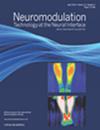枕神经刺激治疗难治性神经性面部疼痛效果不佳:一个病例系列。
IF 3.5
3区 医学
Q2 CLINICAL NEUROLOGY
引用次数: 0
摘要
背景:神经性面部疼痛(NFP)仍然难以进行最佳的药物治疗,这给患者带来了巨大的负担,对疼痛专家也是一个挑战。最近的临床证据表明,周围神经刺激(PNS)在治疗枕神经痛和面神经疼痛方面具有治疗潜力。本研究旨在评估枕神经刺激(ONS)治疗NFP的有效性。材料和方法:我们进行了一个回顾性的病例系列,包括前瞻性入组的难治性NFP患者,这些患者对最佳的特异性药物治疗和某些情况下的运动皮质刺激无反应。这些患者在使用ONS治疗单侧NFP的同情使用框架下进行治疗。每位患者都接受了持续至少两周的初始ONS试验。如果他们的NFP指数下降了40%,他们将在一个月后进行最终植入。结果:共纳入13例患者,平均年龄66岁,男女比例为1.2:1。从NFP发病到ONS手术的平均持续时间为9.6年。在试验期间,只有6名患者(46%)经历了显著的改善并进行了植入。然而,其中三名患者(23%)在植入一个月后没有报告任何益处,这促使了硬体移除。此外,在两名患者(15%)中,最初的改善并没有转化为长期的缓解。最终,只有一名患者(8%)报告NFP持续长期改善。值得注意的是,该患者在接受ONS之前已经从运动皮层刺激中获益10年。结论:根据我们的研究结果,在少数患者中观察到的有限和不一致的改善表明,ONS可能不是NFP的可靠手术治疗选择。本文章由计算机程序翻译,如有差异,请以英文原文为准。
Poor Effectiveness of Occipital Nerve Stimulation in Treating Refractory Neuropathic Facial Pain: A Case Series
Context
Neuropathic facial pain (NFP) that remains refractory to optimal pharmacologic management imposes a significant burden on patients and a challenge to pain specialists. Recent clinical evidence indicates that peripheral nerve stimulation (PNS) exhibits therapeutic potential in managing occipital and facial neuropathic pain. This study aims to evaluate the effectiveness of occipital nerve stimulation (ONS) specifically in the treatment of NFP.
Materials and Methods
We conducted a retrospective case series involving prospectively enrolled patients with refractory NFP unresponsive to optimal specific medical therapy and in some instances motor cortex stimulation. These patients were treated under a compassionate use framework for unilateral NFP using ONS. Each patient underwent an initial ONS trial lasting a minimum of two weeks. If they experienced an alleviation of their NFP >40%, they proceeded to definitive implantation one month later.
Results
Overall, 13 patients were included in the study, with a mean age of 66 years and a male-to-female ratio of 1.2:1. The average duration from NFP onset to ONS surgery was 9.6 years. During the trial period, only six patients (46%) experienced significant improvement and proceeded to implantation. However, three of these patients (23%) did not report any benefit one month after implantation, motivating hardware removal. In addition, in two patients (15%), the initial improvement did not translate to long-term relief. Ultimately, only one patient (8%) reported sustained long-term improvement in NFP. Notably, this patient had experienced a ten-year benefit from motor cortex stimulation before they underwent ONS.
Conclusion
In light of our results, the limited and inconsistent improvements observed in a minority of patients suggest that ONS may not be a reliable surgical treatment option for NFP.
求助全文
通过发布文献求助,成功后即可免费获取论文全文。
去求助
来源期刊

Neuromodulation
医学-临床神经学
CiteScore
6.40
自引率
3.60%
发文量
978
审稿时长
54 days
期刊介绍:
Neuromodulation: Technology at the Neural Interface is the preeminent journal in the area of neuromodulation, providing our readership with the state of the art clinical, translational, and basic science research in the field. For clinicians, engineers, scientists and members of the biotechnology industry alike, Neuromodulation provides timely and rigorously peer-reviewed articles on the technology, science, and clinical application of devices that interface with the nervous system to treat disease and improve function.
 求助内容:
求助内容: 应助结果提醒方式:
应助结果提醒方式:


